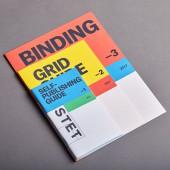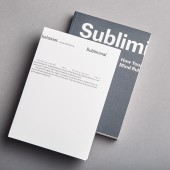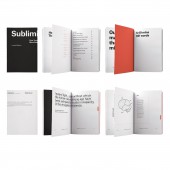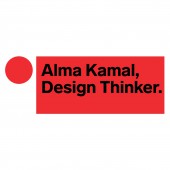Stet Editorial Design by Alma Kamal |
Home > Winners > #112612 |
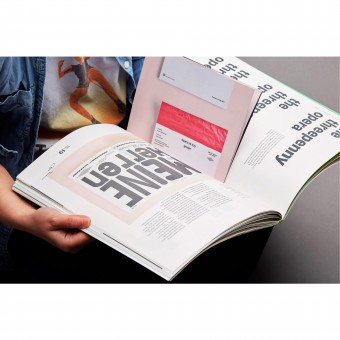 |
|
||||
| DESIGN DETAILS | |||||
| DESIGN NAME: Stet PRIMARY FUNCTION: Editorial Design INSPIRATION: Social Psychology books, Humanities, are essential to people’s growth. They educate, entertain and broaden minds and imaginations. Unfortunately, the design of these books is not nearly as exciting as its contents and it has been static for decades. Reading habits, however, have completely changed due to the internet and are now nonlinear. Therefore, a proposal was born for a new way to design those books. UNIQUE PROPERTIES / PROJECT DESCRIPTION: The world has changed. It has evolved drastically since the invention of movable type, and so have humans. The internet has reshaped reading habits from linear to non-linear. The printed book, however, still retains its traditional form, which causes a disconnect between the reader and the ink on paper. This gap gave reason for Stet to exist. Stet aims to come up with new forms of the printed book to encourage more people to read print, as well as important subjects like Humanities. OPERATION / FLOW / INTERACTION: In this project, design is used to extend the readability and engage readers in a more dynamic narrative experience. Deliverables are a series of 3 booklets. These function as tips for beginner graphic design students and self-publishers about grids, binding, and basic laws of self-publishing. A biannual publication about the latest trends in book design, which designers are breaking the rules and coming up with new exciting definitions of the book.. People like Unit Editions, Visual Editions, Don Norman, and even student projects worth mentioning, as well as reading-related articles and new books worth reading. A formally designed book. The book format will help people with short attention span to read a certain, usually dry, Humanities’ book. An experimental book. This deliverable has given me a chance to alter the content of a chosen Humanities book in order to propose a nonlinear reading of said content. It’s been completely redesigned (format, material, cover, layout, type, visual/graphical elements). The goal here is to push the boundaries of what a book is as an object and to suggest a new way in which books can be designed moving forward in order to fit with people’s new reading habits. 2 Promotional booklets. 1 booklet for the 2 redesigned books explaining the concept and the thought process, another booklet promoting the series of 3 educational booklets. The educational booklet series relate to the books in the sense that it provides self-publishers some knowledge to consider the whole format of the their books. There is a promotional booklet for those, as well as a promotional booklet for the 2 redesigned books. The website is more up to date than the publication and is the place to purchase the other material. Both redesigned books are included in the biannual publication. PROJECT DURATION AND LOCATION: The project started in 2017 and finished in December 2018 in San Francisco. FITS BEST INTO CATEGORY: Graphics, Illustration and Visual Communication Design |
PRODUCTION / REALIZATION TECHNOLOGY: The project consists of 2 redesigned books, 2 promo booklets,a series of 3 educational booklets, a website and a biannual publication. Adobe InDesign, Illustrator and Wix were used for the entire project. All material was printed on Mohawk paper. The educational booklets and promo booklets were saddle stitched, the redesigned books were perfect-bound and the publication was loosely folded with a green rubber band. The publication includes a few bound-in that were saddle-stitched. SPECIFICATIONS / TECHNICAL PROPERTIES: Redesigned Books: 5x7" Publication: 9.5x12.5" Promo Booklets: 4x9" Educational booklets: 1. Self-publishing Guide: 4x6.5" 2. Grid Guide: 6x8.5" 3. Binding Guide: 8x10.5" TAGS: Print Design, Editorial Design, Publication, Identity, Graphic Design, Website, Book, Promo Booklet, Education Booklet, Branding RESEARCH ABSTRACT: First, the designer thought about her relationship to the topic, as well as personal views, examined how designers’ voices are shaped by individual life experiences and personal outlooks through a series of posters that each show a distinct view on the topic chosen, then an 80 questions about the topic. An intensive research was then performed in many directions in order to create a mind map to explore the environmental, economical, social, cultural, political and personal impact of the topic. The next step was to decide who the audience is and create cards for these characters. After that, a gathering of 12 people took place to collect opinions and insight about the topic and the direction of the project. A video proposal was created for Stet. Competitors were studied next and, while there were projects taking place about redesigning existing books, none of them included redesigning the entire book and not just the cover, like the aim in Stet. CHALLENGE: Concept details for the Non-Linear book—Different Levels of Reading; the content is divided into 4 different levels of reading. The first 3 require a lot less time and effort than the 4th one. This gives the reader a choice of how they want to approach the information at any given time. Also, each of these levels starts off with the word count and time estimate of how long it might take you to read through. Extra side information; short biographies of mentioned scientists/names in the text are added in the margins to give the reader a quick introduction. Notes Are in the Text Itself; notes corresponding to certain texts are added within that page, as apposed to the back of the book, for a quicker navigation, especially in case the reader intends to use the book for research purposes. Image Section; all the images are gathered in a section at the end of the book along with their corresponding paragraphs. The reason being is to encourage the reader to interact more with the book. It’s also a way to have an entire visual section that is interesting and functions on its own rather than having to go through the main copy. Concept details for the Experimental book—categorized information; the content in this book was divided into sections of stories, experiments, main ideas, definitions, biographies. Therefore, the longest continuous reading is around 2 pages at most. Fragmented Reading; due to the way the content was divided, the reading becomes very fragmented just like the internet. Therefore, the reader can start from literally any page in the book and work their way backwards or forwards. The content does not require undivided attention or a read-through in one sitting, the reader will not get lost or lose their pace if they put the book down for a month or even a year. Experiment Reading; the book becomes an experiment due to the way the content is laid out and how different that is to the original book. Thus, the object is experimental and an experiment in itself; how differently would readers understand the content as apposed to the original book? The publication is a compilation of the research, the project, and other peoples' projects that relate to Stet. There's also a section that recommends certain designers as well as certain printed books. One of the challenges was to bring all these deliverables together in a cohesive identity/system, yet have them be diverse enough as stand-alones. ADDED DATE: 2020-09-30 23:00:12 TEAM MEMBERS (1) : Creative Director, Concept and Graphic Designer: Alma Kamal and Illustrator: Hamda Alnaimi IMAGE CREDITS: Illustration Copyright: Hamda Alnaimi PATENTS/COPYRIGHTS: Not applicable |
||||
| Visit the following page to learn more: https://www.alma-kamal.com | |||||
| AWARD DETAILS | |
 |
Stet Editorial Design by Alma Kamal is Winner in Print and Published Media Design Category, 2020 - 2021.· Press Members: Login or Register to request an exclusive interview with Alma Kamal. · Click here to register inorder to view the profile and other works by Alma Kamal. |
| SOCIAL |
| + Add to Likes / Favorites | Send to My Email | Comment | Testimonials | View Press-Release | Press Kit |

